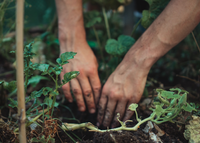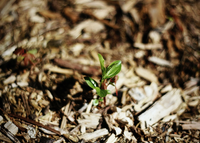Waste not this spring and want not this summer
Water is a seemingly infinite resource—it comes from our hoses, faucets and taps, and we might not think about the luxury of having fresh water at the turn of a knob. But did you know that only 2.5 percent of the planet’s water is fresh, and the majority of that freshwater is found in the polar ice caps? That leaves only around one percent of freshwater found in lakes, rivers, soil and air, and as climate change accelerates (pollution and drought along with it), that amount of usable water continues to decline.
Gardeners have a tremendous opportunity to conserve water usage on their plots. Although it may not seem like a lot, if everyone used less water, or used water more efficiently, we could increase our self-sufficiency for growing food while reducing the demand on our limited water supplies.
Spring is a great time to put some plans into action, as it’s the rainiest and wettest season and—lucky for us—it comes to us right as the gardening season kicks off. If managed properly, spring rain can last you nearly the entire season, so let’s see how we can preserve our spring rain for summer use in the garden.
1. Amend your soil with compost Photo by Jonathan Kemper on Unsplash
Photo by Jonathan Kemper on Unsplash
Compost is an amazing garden resource for many reasons, as its primary function is to help improve soil quality and build soil structure. By creating crumbly textured soil, compost helps air to circulate through sandy or clayed soil, while also allowing for proper water drainage and retention.
In addition to increasing soil’s capacity to hold water, compost also helps prevent erosion. Rather than plant roots being stuck in tight soil, the crumbly structure allows plant roots to spread and hold soil structure together. These healthy root systems have an incredible ability to store water for later usage, and even a five percent increase in organic material can quadruple the water-holding capacity of the soil.
Water can often dry up quickly in unamended soil, so applying compost to your garden before the spring rains will allow it to act as a sponge, absorb the spring rain early on, and slowly release it through the periods of summer drought.
2. Mulch your soil Photo by Maddy Baker on Unsplash
Photo by Maddy Baker on Unsplash
Mulch, much like compost, can be used for the garden to improve soil health and prevent soil erosion. Mulch is a wonderful and affordable option for both the new, experimenting gardener and the large-scale hobby farmer who is looking to retain water for their bigger plot.
Not only does mulching block sunlight from directly hitting the dark soil, preventing water from evaporating and the bed drying up easily, but it also helps to hold water in the soil, saving you time (and resources) each day.
Mulch is a water-saving grace for gardeners, but it also has multiple other benefits. It’s known for maintaining optimal soil temperature and preventing weeds from germinating and spreading, which is a win-win for gardeners.
Mulching retains up to 80 percent of added moisture in soil, and it can continue to absorb more rainwater through the winter if left year-round as well. There are different types of mulch that will best suit your gardening/water retention needs based on your location and soil, and you can find out which is best for you here.
3. Capture rainwater
 Photo by Amritanshu Sikdar on UnsplashEven though you have compost and mulch doing the work of retaining moisture in your garden, there may still be a hot spell or two through the season that will require you to manually water your crops. Fall through spring are the wettest times of the year, whereas summers can often run dry, and a little bit of early planning can help you capture some of that water and use it later on.
Photo by Amritanshu Sikdar on UnsplashEven though you have compost and mulch doing the work of retaining moisture in your garden, there may still be a hot spell or two through the season that will require you to manually water your crops. Fall through spring are the wettest times of the year, whereas summers can often run dry, and a little bit of early planning can help you capture some of that water and use it later on.
The rainwater collection setup can be as simple as gardeners setting up their homes’ eavestroughs to overflow into a water barrel to hand water the garden, or as elaborate as harvesting rainwater through a collection system connected to an irrigation or sprinkler system.
Along with saving money and resources, capturing rainwater is beneficial for the garden as it's free of chemicals and other pollutants (like chlorine), which inhibits growth in plants. Another benefit of using rainwater is that its natural temperature is better adapted to plants rather than shocking them with cold water and potentially harming them. Capturing the water also prevents our local storm-drain systems from becoming overwhelmed, which helps to restore and recharge our groundwater systems while reducing the quantity of pollutants that run from our yards and roads into the waterways.
It’s possible to plan how much water you need to save based on your average yearly rainfall. Even though it might seem like extra effort, it will save you the stress of running out of water mid-season.
Combining these three simple steps into your spring garden plans will guarantee that you will water your garden less frequently, save yourself time and money, while also saving on our planet’s very precious and sacred freshwater sources.


